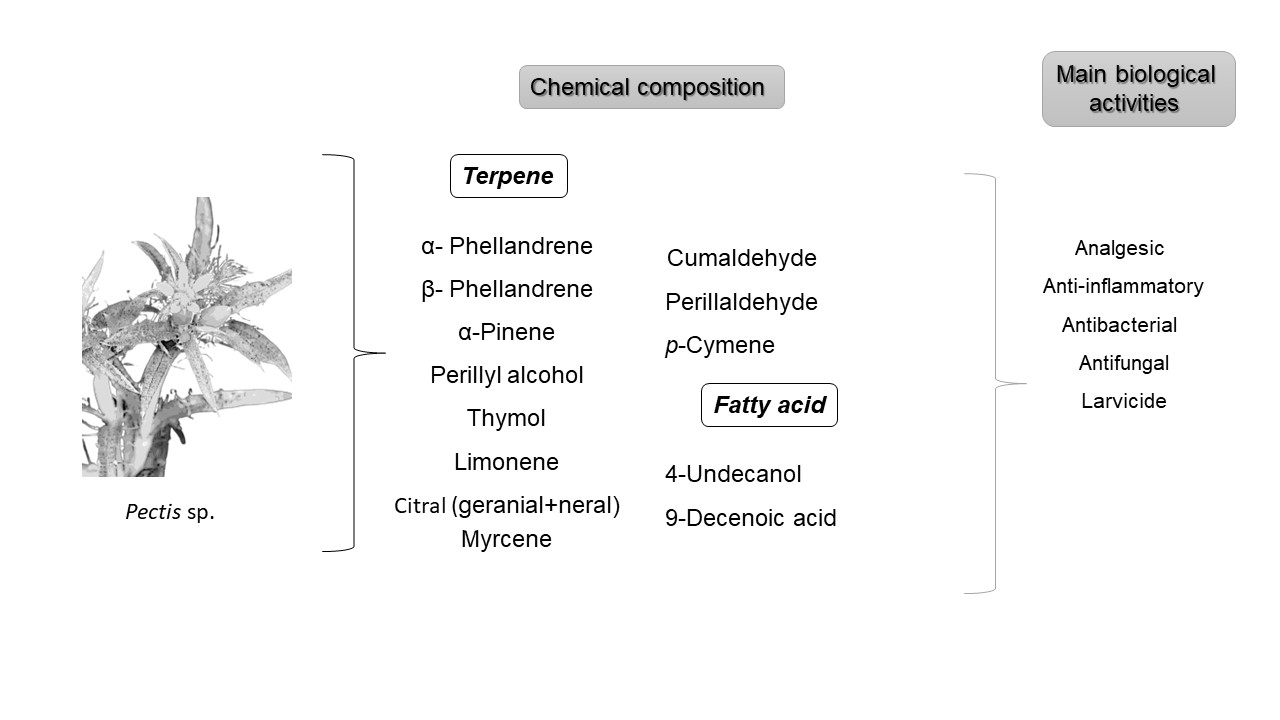Chemical composition and biological activities of essential oils from Pectis spp.
DOI:
https://doi.org/10.70151/xg86d136Keywords:
medicinal plants, essential oils, natural products, monoterpenes, perillyl alcoholAbstract
Natural products from the Brazilian flora have been presented as a vast source of bioactive compounds for the development of drugs. Among the native plants of the national flora, those of the genus Pectis can be found in various hot and dry habitats. The objective of this study was to conduct a review of the available scientific literature on the chemical composition and biological activities of Pectis spp. A search was performed on the Web of Science, Scopus and Pubmed databases using the descriptor “Pectis”. Essential oils and natural compounds of the genus are rich in monoterpenes, citral, thymol, cumaldehyde, perillaldehyde, limonene and perillyl alcohol. These compounds confer to these oils biological activities corroborated by the literature as antibacterial, antifungal, nematicidal, larvicidal, analgesic, anti-inflammatory, and soothing, among others. It can be concluded that the extracts obtained from Pectis spp. have the potential to be used as an alternative to conventional treatments for infectious and inflammatory diseases, but clinical and toxicological (safety) studies need to be carried out.
Downloads
References
Agra MF, Baracho GS, Nurit K, Basílio IJLD, Coelho VPM (2007) Medicinal and poisonous diversity of the flora of "Cariri Paraibano", Brazil. J. Ethnopharmacol. 111: 383-395. https://doi.org/10.1016/j.jep.2006.12.007
Albuquerque MRJR, Costa SMO, Bandeira PN, Santiago GMP, Andrade-Neto M, Silveira ER, Pessoa ODL (2007) Nematicidal and larvicidal activities of the essential oils from aerial parts of Pectis oligocephala and Pectis apodocephala Baker. An Acad Bras Cienc. 79: 209-213. https://doi.org/10.1590/S0001-37652007000200003
Albuquerque MRJR, Souza EB, Mesquita EF, Nunes EP, Cunha NA, Silveira ER (2003) Volatile constituents of the aerial parts of Pectis apodocephala and Pectis oligocephala. J. Essent. Oil Res. 15:372-373. https://doi.org/10.1080/10412905.2003.9698613
Bourdy G, Michel LRC, Roca-Coulthard A (2004) Pharmacopoeia in a shamanistic society: the Izoceño-Guaraní (Bolivian Chaco). J. Ethnopharmacol. 91:189-208. https://doi.org/10.1016/j.jep.2003.09.013
Bradley CE, Haagen-Smit AJ (1949) The essential oil of Pectis papposa. Econ. Bot. 3: 407-412. https://doi.org/10.1007/bf02859170
Damasceno CSB, Higaki NTF, Dias JFG, Miguel MD, Miguel OG (2019) Chemical Composition and Biological Activities of Essential Oils in the Family Lauraceae: A Systematic Review of the Literature. Planta Med. 85: 1054-1072. https://doi.org/ 10.1055/a-0943-1908
Demo M, Oliva MM, López ML, Zunino MP, Zygadlo JA (2005) Antimicrobial activity of essential oils obtained from aromatic plants of Argentina. Pharm. Biol. 43:129-134. https://doi.org/10.1080/13880200590919438
Downum KR, Villegas S, Rodriguez E, Keil D (1989) Plant photosensitizers: A survey of their occurrence in arid and semiarid plants from North America. J. Chem. Ecol. 15: 345-355. https://doi.org/10.1007/BF02027795
Jesus GS, Micheletti AC, Takahashi KM, Matayoshi T, Pott A, Yoshida NC (2020) Antimicrobial potential of Pectis substriata essential oil (Asteraceae) against drug-resistant Staphylococcus strains. An. Acad. Bras. Ciênc. 92: e20200456. https://doi.org/10.1590/0001-3765202020200456
Lemos ICS, Delmondes GA, Santos ADF, Santos ES, Oliveira DR, Figueiredo PRL, Alves DA, Barbosa R, Menezes IRA, Coutinho HDM, Kerntopf MR, Fernandes GP (2016) Ethnobiological survey of plants and animals used for the treatment of acute respiratory infections in children of a traditional community in the municipality of barbalha, Ceará, Brazil. Afr. J. Tradit., Complementary Altern. Med. 13: 166-175. https://doi.org/10.21010/ajtcam.v13i4.22
Lorenzi H, Matos FJA (2002) Plantas Medicinais no Brazil: Nativas e Exóticas. 1ª ed. São Paulo: Instituto Plantarum. 512p.
Marques AM, Lima CHP, Alviano CS, Esteves RL, Kaplan MAC (2013) Traditional use, chemical composition and antimicrobial activity of Pectis brevipedunculata essential oil: A correlated lemongrass species in Brazil. Emir. J. of Food Agric. 25: 798-808. https://doi.org/10.9755/ejfa.v25i10.16408
Marques AM, Kaplan MAC (2013) Preparative isolation and characterization of monoterpene isomers present in the citral-rich essential oil of Pectis brevipedunculata. J. Essent. Oil Res. 25: 210-215. https://doi.org/10.1080/10412905.2013.767756
Matos SP, Teixeira HF, Lima AAN, Veiga-Junior VF, Koester LS (2019) Essential Oils and Isolated Terpenes in Nanosystems Designed for Topical Administration: A Review. Biomolecules. 9(4): 138. 10.3390/biom9040138
Moleyar V, Narasimhaum P (1988) Fungitoxicity of binarinq mixtures of citral, cinnanic aldehyde, menthol and lemongrass oil against Aspergillus niger and Rhizopus stolonifer. Lebensm.-Wiss. Technol. 21: 100-102. Available in: http://ir.cftri.res.in/id/eprint/2288
Ninkuu V, Zhang L, Yan J, Fu Z, Yang T, Zeng H (2021) Biochemistry of Terpenes and Recent Advances in Plant Protection. Int J Mol Sci. 22(11): 5710. https://doi.org/10.3390/ijms22115710
Oliveira MTR, Berbert PA, Martinazzo AP, Berbert-Molina MA (2011) Drying kinetics of lemon-scented grass. Trans. ASABE. 54: 1837-1846. https://doi.org/10.13031/2013.39823
Pereira SL, Marques AM, Sudo RT, Kaplan MAC, Zapata-Sudo G (2013) Vasodilator activity of the essential oil from aerial parts of Pectis brevipedunculata and its main constituent citral in rat aorta. Molecules. 18: 3072-3085. https://doi.org/10.3390/molecules18033072
Pereira SF, Barroso A, Mourão RHV, Fernandes CP (2021) A Low Energy Approach for the Preparation of Nano-Emulsions with a High Citral-Content Essential Oil. Molecules. 26: 3666. https://doi.org/10.3390/molecules26123666
Pino JA, Rosado A, Fuentes V (1996) Chemical composition of the leaf oil of Pectis prostrata Cav. From Cuba. J. Essent. Oil Res. 8: 579-580. https://doi.org/10.1080/10412905.1996.9700697
Pino JA, Rosado A, Fuentes V (1999) Composition of the essential oil of Pectis floribunda A. Rich. J. Essent. Oil Res. 11: 31-32. https://doi.org/10.1080/10412905.1999.9701062
Prudent D, Perineau F, Bessieri JM, Michel G (1995) Analysis of the Essential Oil of Pectis elongata Kunth. From Martinique. Evaluation of its Bacteriostatic and Fungistatic Properties. J. Essent. Oil Res. 7: 63-68. https://doi.org/10.1080/10412905.1995.9698464
Prudent D, Perineau F, Bessieri JM, Michel G, Bravo R (1993) Chemical analysis, bacteriostatic and fungistatic properties of the essential oil of the Atoumau from Martinicpe (Alpinia speciosa K. Schum.). J. Essent. Oil Res. 5: 255-264. https://doi.org/10.1080/10412905.1993.9698218
Salgado VG, Gutiérrez DG. Pectis in Flora e Funga do Brasil. Jardim Botânico do Rio de Janeiro. Available in: <https://floradobrasil.jbrj.gov.br/FB16235>
Silva MHL, Andrade EHA, Maia JGS (2005) The essential oil of Pectis elongata Kunth occuring in North Brazil. Flavour Fragrance J. 20: 462-464. https://doi.org/10.1002/ffj.1546
Zheng Y, Shang Y, Li M, Li Y, Ouyang W (2021) Antifungal Activities of cis-trans Citral Isomers against Trichophyton rubrum with ERG6 as a Potential Target. Molecules. 26: 4263. https://doi.org/10.3390/molecules26144263

Downloads
Published
Issue
Section
License

This work is licensed under a Creative Commons Attribution-NonCommercial-NoDerivatives 4.0 International License.

